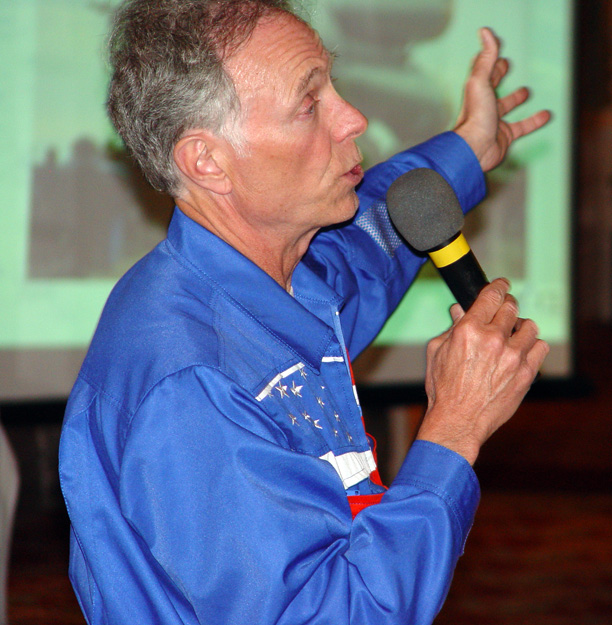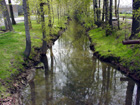The keynote speaker at the New Jersey Aviation Hall of Fame 33rd Annual Induction Dinner on May 24th was Greg Olsen. Mr. Olsen is the New Jersey scientist who paid $20 million to ride into space and was the third private citizen to orbit the earth on the International Space Station (ISS). Using photos and movie clips, Mr. Olsen shared his astronomical exploits. The 59 year old scientist and
entrepreneur began cosmonaut training in April 2004, but Russian space officials later
said he could not fly due health concerns related to the high G-force in space flight. The
undisclosed medical problem was remedied allowing Olsen to advance his dream and resume
training on May 14, 2005. After five months (900 hours) of training at the Yuri Gagarin Cosmonaut Training Center in Moscow, he launched on a Russian Soyuz rocket TMA-7 on October 1, 2005, docked to the ISS on October 3rd and returned to Earth on October 11th on the Soyuz TMA-6. Mr. Olsen flew with ISS’s replacement crew Cosmonaut Valeri Tokarev and Astronaut Bill McArthur. "Going up it got a little over 3, 3.3 G’s -- you could really feel it. When you tried to lift your hand, it was like a 10 pound weight on your hand, then all of a sudden after about 8 minutes, your hand just floats up by itself," he said. "Soyuz is mostly automated, the only time you’re manual is docking, after system checks, hatches were opened. The crew transferred cargo and continued hand-over activities." His talk provided many details about life aboard the space station -- living and working in a gravity free environment, space housekeeping chores, etc. Living quarters were like a series of connected trailers about 300 ft. long. It was more crowded than expected and the food was more than satisfactory. There’s no gravity to mix hot and cold air, so fans are constantly circulating the air to make sure the CO2 gets filtered out. With all the fans working, it is noisy. Temperature control is done with an outside radiator which faces or turns away from the sun to maintain the temperature. Mr. Olsen described the daily life on board to include: sleeping belted against a wall, eating, drinking liquids from bags and sipped with straws, etc. ISS residents take sponge baths, carefully storing refuse for return to Earth while advanced air-suction systems take care of bodily wastes. Exercise is done on a treadmill and exercise bike. Astronauts have to strap themselves down to the exercise machines. He spent time floating around in space, looking out the window, photographing and making videos. He actually lost his camera when it floated out of his pocket -- it’s still up there. He viewed New Orleans and saw all the flooding. "It was kind of like this wondrous thing ... we have seen thousands of pictures of the Earth, but to see it with your own eyes and then say ‘It really is round, and how finite it is’ ... you see this little crust of atmosphere against the dark sky and realize we don’t have that much to breathe." Orbiting 250 miles above sea level, Greg performed over 160 orbits and logged over 3 million miles of weightless travel during his 10 days in space. Orbiting the Earth 100 times, he saw 80 sunrises and 80 sunsets. During sleep time the shades are closed -- and they are awakened by an alarm. "I do not consider myself as a space tourist, but first and foremost a scientist." He participated in a research program that studied the human body’s response to the micro gravity environment. The experiments were designed to study the possible cause of nausea and lower back pain, as well as the evolution of human bacterial flora. The descent from the station
orbiting approximately 240 miles above the Earth took about 3-1/2 hours and at about 4.5
G’s before touchdown of his space capsule on the cold, wind-swept steps of northern
Kazakhstan. Olsen has given over 100 lectures this year to primarily Sixth, Seventh and Eighth Graders. He hopes to inspire more American children, especially females and minorities, to pursue science and engineering careers. "Don’t give up," Olsen tells students. "I got into space because I didn’t give up. I had some setbacks, but I didn’t let them stop me." His message: "hard work and determination
have led me to where I am today and I encourage today’s youth to dream big. If I can
do it, so can you." ### Mr. Olsen was the New Jersey scientist who paid $20 million to ride into space and was the third private citizen to orbit the earth on the International Space Station (ISS). After training for five months (900 hours) at the Yuri Gagarin Cosmonaut Training Center in Moscow, he launched on a Russian Soyuz rocket TMA-7 on October 1, 2005, docked to the ISS on October 3rd and returned to Earth on October 11th on the Soyuz TMA-6. Mr. Olsen flew up with Cosmonaut Valeri Tokarev and Astronaut Bill McArthur. Greg performed over 160 orbits and logged almost 4 million miles of weightless travel during his 10 days in space. Greg received a BS in Physics (1966), a BSEE and MS in Physics (1968) from Fairleigh Dickinson University, then was awarded a Ph.D in Materials Science from the University of Virginia (1971). He performed post-doctoral studies at the University of Port Elizabeth (South Africa), taught elementary physics classes and worked as a research scientist at RCA Labs (Sarnoff Center) from 1972 to 1983. He developed vapor phase epitaxial crystal growth of optoelectronic devices, including laser diodes and photodectors for fiber optic applications based on the material idium gallium arsenide (InGaAs). Mr. Olsen was awarded 12 patents, wrote over 100 technical papers, co-authored several book chapters and gives numerous invited lectures to both technical and trade journal audiences. Greg is an IEEE LEOS Fellow and first recipient of the IEEE Aron Kressel Award. Mr. Olsen founded EPITAXX, a fiber-optic detector manufacturer in 1984 with Vladimir Ban and sold it in1990 for $12 million. He then founded Sensors Unlimited, a near-infrared camera manufacturer in 1992 with Marshall Cohen. Sensors was sold to Finisar Corp. for $600 million in 2000, repurchased by the management team in 2002 for $6 million, then sold again to Goodrich Corp. in 2005 for $60 million. After an illustrious career as a research scientist and entrepreneur, Mr. Olsen is now president of GHO Ventures in Princeton, NJ where he manages his "angel" investments. He performs numerous speaking engagements to encourage children -- especially minorities and females -- to consider careers in science and engineering. He is active in the New Jersey Technology Counsel and the NJ Commission on Science and Technology. Greg is active in many civic organizations including Trenton Big Brothers and Sisters, Trenton Boys and Girls Club, Trenton Soup Kitchen, Princeton Historical Society and Custer Battlefield Preservation Committee. In his spare time he enjoys golf, country and western music and dancing, opera and horseback riding. For more information or for reservations to the NJ Aviation Hall of Fame 33rd Annual Induction Dinner, please call 201-288-6344. Tickets are $100. ###
|









